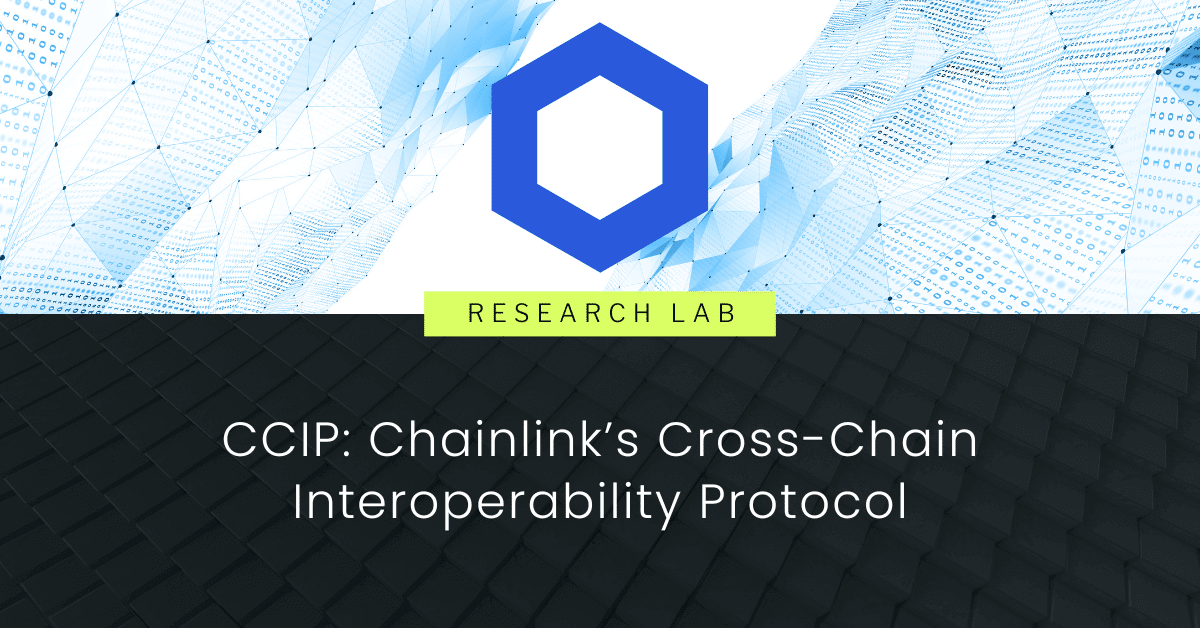Content
- The Problem with Cross-Chain Interoperability
- What is CCIP?
- How Does CCIP Work?
- Off-Chain Reporting Layer
- CCIP Layer
- Application Layer
- Anti-Fraud Network
- Use-case example: SWIFT
- Conclusion
- About Zerocap
- FAQs
- What is the problem with cross-chain interoperability?
- What is CCIP and how does it aim to solve the problem of cross-chain interoperability?
- How does the CCIP work?
- What is the role of the Anti-Fraud Network in CCIP?
- What are some use-case examples of CCIP?
- DISCLAIMER
7 Jul, 23
CCIP: Chainlink’s Cross-Chain Interoperability Protocol

- The Problem with Cross-Chain Interoperability
- What is CCIP?
- How Does CCIP Work?
- Off-Chain Reporting Layer
- CCIP Layer
- Application Layer
- Anti-Fraud Network
- Use-case example: SWIFT
- Conclusion
- About Zerocap
- FAQs
- What is the problem with cross-chain interoperability?
- What is CCIP and how does it aim to solve the problem of cross-chain interoperability?
- How does the CCIP work?
- What is the role of the Anti-Fraud Network in CCIP?
- What are some use-case examples of CCIP?
- DISCLAIMER
Today, hundreds of different layer 1 and layer 2 blockchains exist. The emergence of these blockchains is largely due to the cause and effect of the various limitations of monolithic blockchain architecture, which has forced developers to embrace modular frameworks. Without modularity, blockchains are forced to operate within the confines of the scalability trilemma. Modularity diversifies the workload from a single network across an array of specialist protocols, allowing developers to utilise protocols for application-specific tasks. The problem is, blockchains cannot natively communicate with each other, requiring a third-party technology, known as ‘layer 0’. CCIP is a type of layer 0, that facilitates interoperability between different blockchain systems.

The Problem with Cross-Chain Interoperability
Developing cross-chain applications is widely recognized as a challenging task, primarily due to the shortcomings of existing cross-chain infrastructure. One of the main challenges is the fragmentation that exists in token bridges and messaging protocols, most of which are application-specific services designed to operate between two distinct chains. Furthermore, a lot of these bridges are highly centralised, providing weak security guarantees, with node operators lacking transparency or reliability, and end-users facing increased costs and processing times. Cross-chain bridge exploits account for 50% of all DeFi exploits over the last two years, totalling US 2.5 billion in value since September 2020. Due to these limitations and vulnerabilities, there have been significant instances of funds lost. This exploitation has hindered the progress of cross-chain innovation.
What is CCIP?
CCIP is an open-source standard that facilitates the exchange of data packets between smart contracts on different blockchain networks. The Chainlink CCIP initiative aims to revolutionize cross-chain communication. Similar to how TCP/IP ensures that data is transmitted reliably between devices, CCIP ensures that data is transmitted reliably between blockchains. The protocol is set to release at some point within 2023 and aims to be the standard protocol for cross-chain interoperability. This acts as a layer of abstraction, enabling developers to build cross-chain applications effortlessly without needing to understand the complexities of the underlying protocols. CCIP-based applications, such as Chainlink’s own Programmable Token Bridge, other cross-chain bridges, and cross-chain dApps, can leverage the security of the Anti-Fraud Network to automate the detection and mitigation of fraudulent activity. Additionally, CCIP is exploring more secure approaches to protect against nefarious activity, such as trusted execution environments, hardware security modules, crypto-economic security through staking, and more. An interesting feature of CCIP is that the protocol is natively compatible with all blockchains.
How Does CCIP Work?
There are three layers of the interoperability stack and an anti-fraud network that operates alongside the stack. The bottom layer is the transport and consensus layer which ensures reliable and efficient messaging on top of it. Chainlink has developed off-chain reporting (OCR 2.0) to scale this layer. The second layer is CCIP, which is an open standard that enables developers to send messages and instructions to other contracts across blockchains. The third layer is the application layer where services like programmatic token bridges or DeFi applications can be built. Additionally, alongside these layers lies the Chainlink Anti-Fraud Network. The CCIP bridge offers a seamless solution for cross-chain data transfer.
Off-Chain Reporting Layer
The OCR protocol is a way for Chainlink nodes to combine their observations into a single off-chain report, which is then securely submitted to the blockchain. The report is made up of many observations from different nodes and must be signed by a group of them. These signatures are then verified on the blockchain. While previous oracle consensus protocols required each node in the network to submit a separate transaction to the blockchain for each observation they made, resulting in high gas fees and slow confirmation times for each report; OCR improves upon this by allowing nodes to communicate with each other off-chain and aggregate their observations into a single report. Only one node needs to submit the report to the blockchain, and each report is signed by a quorum of nodes to ensure its accuracy. This reduces gas fees, improves scalability, and allows data feeds to be updated more quickly.
OCR 2.0 works by selecting a leader to facilitate communication, and this leader requests observations from every node in response. In the case of cross-chain, there will be token movements and messaging events made from one chain with a request to deliver them to a destination chain. The leader collects these observations and broadcasts both the query and the signed observations to all nodes. All participants then need to decide if the report should be generated on-chain. Each participant will then need to sign the report and send it to the leader. The leader collects the signed reports and shares the final report for transmission. Nodes take turns transmitting the final report on-chain.
CCIP Layer
The Cross-Chain Interoperability Protocol and OCR 2.0 communicate with each other via a set of APIs. CCIP enables smart contracts on any blockchain to exchange data packets with smart contracts on any other blockchain network, while OCR allows Chainlink nodes to retrieve and aggregate off-chain data in a decentralised manner. In a cross-chain application that utilises CCIP, the smart contract on one blockchain would send a message to the Chainlink nodes through CCIP. The Chainlink network’s nodes would then observe this message event and aggregate this observation using OCR 2.0, and provide it to the destination smart contract via CCIP.
Application Layer
The application layer presents numerous opportunities for developers to easily build cross-chain applications without the need to understand the inner workings of each blockchain that the application connects to. A simple example of a cross-chain application could be a cross-chain bridge that allows users to transfer assets from one blockchain to another. Another example might be a DeFi application that allows users to get a loan with Ethereum while using a Bitcoin or another non-Ethereum-based cryptocurrency as collateral.
Chainlink plans to launch its own reference cross-chain token bridge implementation upon the launch of CCIP. The application will utilise the full interoperability stack, including OCR 2.0, CCIP and the Chainlink Anti-Fraud Network. In theory, this stack will enable complex cross-chain applications to be built, such as cross-chain yield harvesting, cross-chain collateralised loans as well as a plethora of new kinds of DeFi applications that were previously not viable to build prior to the release of CCIP. The release of Chainlink’s cross-chain token bridge application aims to set a standard for developers to innovate atop the interoperability stack.
Anti-Fraud Network
Chainlink has developed the Anti-Fraud Network to safeguard its network against fraudulent activities. This network functions in a similar manner to traditional anti-fraud departments and sophisticated AI-based systems that manage risks. The Anti-Fraud Network is responsible for monitoring all activities on Chainlink’s messaging and bridging systems, which facilitate cross-chain communication and token movement. By continually scanning for potential issues such as reorganisations, insufficient confirmations, and other suspicious events, the network can detect and prevent fraudulent or malicious events. To achieve this, the network employs automated smart contracts that are activated by predefined events to manage and mitigate potential risks. This ensures that Chainlink’s messaging protocol and programmable bridges operate within acceptable levels of risk as specified by its users. Therefore, the Anti-Fraud Network represents an advanced risk management system that protects Chainlink’s decentralised network.
Use-case example: SWIFT
SWIFT (Society for Worldwide Interbank Financial Telecommunication) is a global, member-owned cooperative established in 1973, headquartered in Belgium. It provides a network for secure financial transactions among its members. Rather than transferring funds directly, it uses BIC codes to send payment orders between financial institutions globally. The SWIFT network is instrumental in global finance, facilitating 33 million financial messages daily between over 11,000 financial institutions in more than 200 countries. This represents a substantial portion of international interbank messages, particularly for payments and securities transactions. Thus, SWIFT plays a significant role in enabling global money transfers.
On June 6, 2023, SWIFT made an announcement regarding their active testing of Chainlink’s CCIP to address the current interoperability challenges within the blockchain ecosystem. Initially, CCIP will serve as an enterprise abstraction layer, facilitating secure connectivity between the SWIFT network and the Ethereum network. In many respects, SWIFT can be regarded as one of the pioneering Decentralised Autonomous Organisations. Moreover, its ledger of transactions and financial data functions akin to a blockchain, making it an ideal platform to explore connectivity between Ethereum and the SWIFT network. The implementation of CCIP significantly enhances the security and efficiency of communication between these two networks, thanks to the diverse features inherited by CCIP.
Conclusion
Modularity has enabled developers to utilise specialist protocols for application-specific tasks, however, the inability of blockchains to natively communicate with each other has hindered cross-chain innovation. CCIP is a type of layer 0 technology that facilitates interoperability between different blockchain systems. Despite the challenges of cross-chain infrastructure, CCIP aims to become the standard protocol for cross-chain interoperability by providing a layer of abstraction for developers to build cross-chain applications without the need to understand the underlying protocols. By leveraging the security of the Anti-Fraud Network, CCIP-based applications have the ability to automate the detection and mitigation of fraudulent or malicious activity, further improving the security of cross-chain transactions. Through the three layers of the interoperability stack and the Anti-Fraud Network, CCIP provides a reliable and efficient messaging system, enabling a new world of possibilities for cross-chain applications.
About Zerocap
Zerocap provides digital asset liquidity and custodial services to forward-thinking investors and institutions globally. For frictionless access to digital assets with industry-leading security, contact our team at [email protected] or visit our website www.zerocap.com
FAQs
What is the problem with cross-chain interoperability?
Developing cross-chain applications is a challenging task due to the fragmentation that exists in token bridges and messaging protocols, most of which are application-specific services designed to operate between two distinct chains. Many of these bridges are highly centralised, providing weak security guarantees, and end-users face increased costs and processing times. Cross-chain bridge exploits account for 50% of all DeFi exploits over the last two years, totalling US 2.5 billion in value since September 2020.
What is CCIP and how does it aim to solve the problem of cross-chain interoperability?
CCIP (Chainlink’s Cross-Chain Interoperability Protocol) is an open-source standard that facilitates the exchange of data packets between smart contracts on different blockchain networks. Similar to how TCP/IP ensures that data is transmitted reliably between devices, CCIP ensures that data is transmitted reliably between blockchains. The protocol aims to be the standard protocol for cross-chain interoperability, enabling developers to build cross-chain applications effortlessly without needing to understand the complexities of the underlying protocols.
How does the CCIP work?
There are three layers of the interoperability stack and an anti-fraud network that operates alongside the stack. The bottom layer is the transport and consensus layer which ensures reliable and efficient messaging. The second layer is CCIP, which enables developers to send messages and instructions to other contracts across blockchains. The third layer is the application layer where services like programmatic token bridges or DeFi applications can be built. The Anti-Fraud Network monitors all activities on Chainlink’s messaging and bridging systems to detect and prevent fraudulent or malicious events.
What is the role of the Anti-Fraud Network in CCIP?
Chainlink has developed the Anti-Fraud Network to safeguard its network against fraudulent activities. This network functions in a similar manner to traditional anti-fraud departments and sophisticated AI-based systems that manage risks. The Anti-Fraud Network is responsible for monitoring all activities on Chainlink’s messaging and bridging systems, which facilitate cross-chain communication and token movement. By continually scanning for potential issues such as reorganisations, insufficient confirmations, and other suspicious events, the network can detect and prevent fraudulent or malicious events.
What are some use-case examples of CCIP?
A simple example of a cross-chain application could be a cross-chain bridge that allows users to transfer assets from one blockchain to another. Another example might be a DeFi application that allows users to get a loan with Ethereum while using a Bitcoin or another non-Ethereum-based cryptocurrency as collateral. On June 6, 2023, SWIFT announced their active testing of Chainlink’s CCIP to address the current interoperability challenges within the blockchain ecosystem. Initially, CCIP will serve as an enterprise abstraction layer, facilitating secure connectivity between the SWIFT network and the Ethereum network.
DISCLAIMER
Zerocap Pty Ltd carries out regulated and unregulated activities.
Spot crypto-asset services and products offered by Zerocap are not regulated by ASIC. Zerocap Pty Ltd is registered with AUSTRAC as a DCE (digital currency exchange) service provider (DCE100635539-001).
Regulated services and products include structured products (derivatives) and funds (managed investment schemes) are available to Wholesale Clients only as per Sections 761GA and 708(10) of the Corporations Act 2001 (Cth) (Sophisticated/Wholesale Client). To serve these products, Zerocap Pty Ltd is a Corporate Authorised Representative (CAR: 001289130) of AFSL 340799
All material in this website is intended for illustrative purposes and general information only. It does not constitute financial advice nor does it take into account your investment objectives, financial situation or particular needs. You should consider the information in light of your objectives, financial situation and needs before making any decision about whether to acquire or dispose of any digital asset. Investments in digital assets can be risky and you may lose your investment. Past performance is no indication of future performance.
Like this article? Share
Latest Insights
Weekly Crypto Market Wrap: 21st October 2024
Zerocap is a market-leading digital asset firm, providing trading, liquidity and custody to forward-thinking institutions and investors globally. To learn more, contact the team at
CoinDesk Spotlights Zerocap | Bitcoin-Dollar Correlation Shaken Ahead of U.S. Election
Read more in a recent article in CoinDesk. 21 October, 2024: As the U.S. presidential election on November 5 approaches, financial markets are shifting rapidly, with
The Defiant Featured Zerocap | Bitcoin Breaks $65K as Short Traders Face Liquidations
Read more in a recent article in The Defiant and our 14th October Edition Weekly Wrap. 16 October, 2024: The cryptocurrency market experienced a significant
Receive Our Insights
Subscribe to receive our publications in newsletter format — the best way to stay informed about crypto asset market trends and topics.



 Share
Share  Tweet
Tweet  Post
Post 